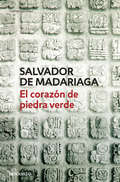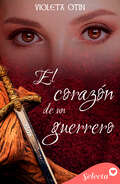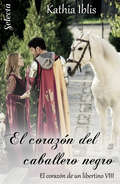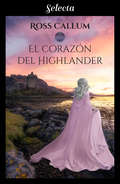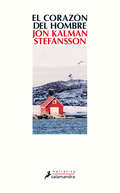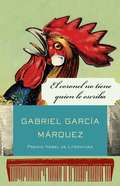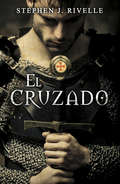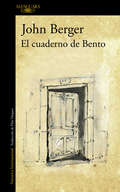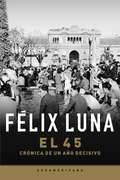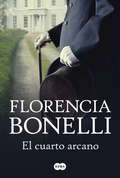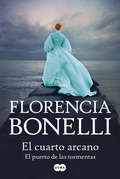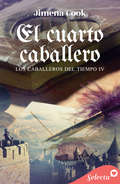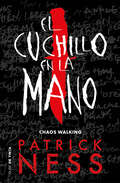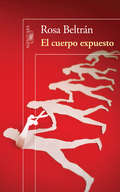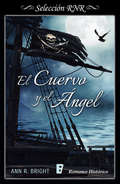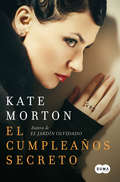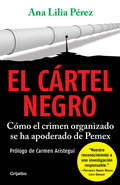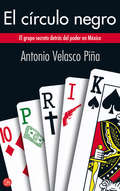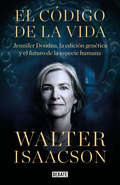- Table View
- List View
El contrato social
by Jean Jacques RousseauEL CONTRATO SOCIAL (1762), ES UNA DE LAS OBRAS MÁS IMPORTANTES DEL PENSAMIENTO POLÍTICO. EL RETO QUE EN ESTE LIBRO LANZA SU AUTOR: SU PROPUESTA DE VIVIR EN LA MÁS ESTRICTA IGUALDAD, SIGUE SIENDO UN IMPORTANTE ACICATE PARA TODOS AQUELLOS QUE SE AVENTURAN A CUESTIONAR EL ORDEN POLÍTICO, ENTENDIENDO QUE NO ES ALGO INAMOVIBLE Y DADO PARA SIEMPRE, SINO HUMANO Y POR ELLO PERFECTIBLE, RECUSABLE O PLAUSIBLE.
El corazón de Lachlan
by Suzan TisdaleLa saga de los MacCullough continúa... Lachlan MacCullough no quiere ser laird. Él nunca lo hizo. Pero cuando su primo, Black Richard, le pide que gobierne las posesiones recientemente conquistadas de Randall Chisolm hasta que el primogénito de Black Richard tenga la edad suficiente para hacerlo, no puede negar la solicitud. A pesar de que lo alejará de la única mujer que quiere... Keevah. Keevah no puede escapar de su pasado. Conocida como la vieja puta, ni siquiera su amistad con la esposa de Black Richard, Aeschene, la librará de los rumores y las calumnias que la han perseguido durante años. Pero hay cosas peores que ser rechazado. Cuando Keevah recibe la noticia de que un viejo y querido amigo se está muriendo, debe regresar a Inverness para despedirse y cumplir una vieja promesa. Ese giro del destino la une una vez más con Lachlan, un hombre al que ama pero del que se siente desesperadamente indigno. También la pone en el camino de un asesino trastornado que intenta librar al mundo de las prostitutas. ¿Encontrará seguridad y felicidad en los brazos de Lachlan, o pagará el precio final por los pecados de su pasado?
El corazón de piedra verde
by Salvador de MadariagaEl corazón de piedra verde es una obra deslumbrante por la inagotable riqueza de conocimientos que revela su autor, por la vivacidad con que recrea el pasado de un continente y por la nobleza de sus propósitos. A lo largo de sus tres partes "Los fantasmas", "Los dioses sanguinarios" y "Fe sin blasfemia" Salvador de Madariaga logra ofrecer una imagen verosímil del contraste de dos mundos muy dispares, y mostrar la conmoción que la Conquista produjo en los corazones de España y América. Aparecen aquí las historias de Moctezuma y Cortés, de Cuauhtémoc y Bernal Díaz, de los españoles y aztecas que vivieron en una época crucial del desarrollo de las civilizaciones. Una serie de personajes -algunos entrañables, otros deleznables, todos humanos- desfilan por las páginas de esta trilogía: en ellos podemos encontrar las raíces del ser americano. El lector de El corazón de piedra verde difícilmente podrá olvidar los deliciosos momentos que deparará la compañía de este libro ya clásico de Salvador de Madariaga.
El corazón de un guerrero
by Violeta OtínCuando has tenido que luchar para dejar atrás tu antigua vida, ¿puedes arriesgarte a amar a quien podría traer tu pasado de vuelta? Britania, s. V d.C. El barco se hundió por completo y Aryn pensó que sus años como esclava de los sajones se habían hundido con él. Cogió de la mano a su hija. Volvería con los suyos, y todo volvería a ser como antes. O eso esperaba. Las cosas comenzaron a torcerse cuando la niña cayó enferma y tuvo que recurrir a una curandera: una bruja que vivía sola en mitad de la nada. Una sajona. Garberht, un sajón de pura cepa que un día atravesó los mares para forjarse un nombre, no olvidaba su pasado glorioso como guerrero. El hombre batiéndose cara a cara con la muerte, y demás. Cuando le ocurría, se obligaba a recordarse que ya no era esa clase de hombre. Que ahora era un tipo honrado.Mas el destino es caprichoso y se empeña en juntar a aquellos que deberían permanecer separados. Personas como un guerrero que ya no lo es, pero a quien persigue la guerra; o una antigua esclava que solo desea perder de vista a los sajones de una vez por todas.
El corazón del caballero negro (El corazón de un libertino #Volumen 8)
by Kathia IblisHasta el más oscuro de los corazones despertará al amor y lo protegerá con su vida. La señorita Harriet Leith, una perfecta florero, tan solo espera atravesar otra aburrida temporada cuidando de sus hermanas menores. Sin sobresaltos, ni eventos inesperados. Sin embargo, todo esto cambia gracias a sus dos alocadas hermanas menores y pronto se encuentra atravesado una excitante última temporada que la llevara a los brazos del hombre que ella menos esperaba. Lord Marcus Royce Davenport, más conocido como el Caballero Negro, único heredero del barón de Willoughby, esperaba tener una temporada tranquila. Pese a saberse un buen partido estaba decidido a pasarlo bien con sus viejos camaradas y mantenerse lo más alejado posible del mercado matrimonial. Sin embargo, las circunstancias hacen que sus caminos se crucen y a partir de ese momento sus destinos parecen estar entrelazados. ¿Podrá Harriet conquistar el corazón del libertino caballero?
El corazón del granuja (La guía esencial del arte de seducción para señoritas #4)
by Claire DelacroixHelena encuentra a su igual en este romance de la Regencia lleno de disfraces, identidad equivocada e intriga. Helena Emerson anhela el romance y la aventura, y sueña con casarse con su duque por amor. Sabe que nunca podría soportar un matrimonio con el serio vizconde Addersley, sin importar lo guapo que pueda ser. Consumido por la lógica y el sentido común, el hombre bien podría ser una estatua. ¡Ni siquiera baila! Ella rechaza su oferta de matrimonio para gran disgusto de su familia, pero está decidida a casarse felizmente o no hacerlo en absoluto. Pero Joshua Hargood, séptimo vizconde Addersley, no es el hombre que Helena cree que es. Dejó de lado sus costumbres libertinas una década atrás, culpándose a sí mismo del accidente que se llevó la vida de su prometida. Sin embargo, nunca ha sido capaz de resistir un desafío si a recompensa bien lo merecía, y el desafío de socavar las suposiciones de Helena es tentador más allá de todo. Joshua se disfrazará y planeará ser un granuja solo para la dama con la que planea casarse, convencido de que ese es el mérito de su pasado escandaloso. Helena se encontrará cautivada por su misterioso pretendiente y pronto descubrirá su disfraz, solo para enterarse que el vizconde perdió a su prometida años atrás. ¿Podrá ser su corazón realmente reclamado? Apenas Joshua está convencido de que su artimaña tendrá éxito cuando su hermano, el que cree muerto en Waterloo, regresa para exigir lo que le corresponde. Joshua debe saber que su resentido hermano solo estará satisfecho cuando Addersley sea destruido, junto a su propia felicidad y perspectiva de vida. ¿Estará condenado a ver cómo se repite la tragedia del pasado o podrá Joshua salvar tanto su legado como a su amada Helena?
El corazón del highlander (Bilogía La bruma del tiempo #Volumen 1)
by Ross CallumPrimera entrega de la bilogía «La bruma del tiempo». Una mentira llevará a la protagonista de esta historia a huir de su pasado y la embarcará en una apasionante aventura cinco siglos atrás. Ross Callum nos ofrece una nueva novela de romance histórico ambientada en las Highlands escocesas. «Estaban destinados a encontrarse. Si para alcanzar el cielo antes debes bajar al infierno, ¿cuánto te atreverías a sacrificar?» Jessica Grant, una neoyorkina de veintiséis años, siempre creyó que era un bicho raro. Al contrario que su alocada amiga Abby, que cambia de novio como de calcetines, es incapaz de llenar ese vacío tan parecido a la nostalgia que la ha acompañado toda su vida. Hasta que conoce a Víctor, un exitoso abogado de Manhattan. A una semana de la boda, una mentira la llevará a huir de su pasado, los compromisos sociales y la diabólica plancha del pelo, pero solo la hundirá más en él. Cinco siglos exactamente. En las Highlands de Escocia, atrapada en un tiempo de luchas y superstición, encontrará su destino y a Keillan MacArthur, el último de su clan, un hombre del Renacimiento, un guerrero culto y sensible marcado por profundas heridas. Y hermoso como un dios. ¿Podrá Jessica sanar el corazón del highlander? Cuando la antigua magia despierte para mostrarle que nada es como parece, deberá hacer una elección.
El corazón del hombre (Trilogía del muchacho #Volumen 3)
by Jón Kalman StefánssonAmbientada en Islandia a finales del siglo XIX, esta novela concluye la Trilogía del muchacho. La historia narra el despertar a la edad adulta de su protagonista, el mismo joven sin nombre de las dos primeras partes -Entre cielo y tierra y La tristeza de los ángeles, ambas publicadas con este sello editorial- quien, inmerso en un microcosmos desolado e implacable, donde la geografía es un elemento determinante, experimenta en primera persona la fuerza arrolladora de dos impulsos de alcance universal, el de la supervivencia y el del amor. El muchacho no tiene nombre ni padres ni educación, pero sí una sed insaciable de vida y un fuerte apego a la poesía y la literatura. Durante la larga travesía junto con el cartero Jens, una inesperada tormenta de primavera en un remoto fiordo noroccidental de la isla provoca un alud que sepulta a los viajeros con terribles consecuencias. Cuando el muchacho despierta, es atendido por Ólafur, el médico de la aldea, y su esposa Steinunn, pero lo que seguramente ha precipitado su regreso al mundo de los vivos son la cabellera pelirroja y los ojos verdes de la bella Álfheiður, que lo observan con interés. Así, con la misma cadencia con que primero llega el deshielo y luego la primavera se despliega hasta fundirse en el crepuscular y fugaz verano nórdico, el muchacho irá descubriendo el amor hasta hacerse un hombre. Y una vez recuperada la salud, este nuevo hombre, aún turbado por los espíritus de los muertos, iniciará con su compañero Jens el regreso a casa, como una suerte de Ulises de los hielos. Reseñas:«Un autor que produce una honda impresión [...]. Escribe con calidez y humor sobre cuestiones universales que tocan cualquier orden social [...]. Su escritura es cuanto menos sublime.»Flensborg Avis «La poesía anima y alienta la prosa de Stefánsson. En El corazón del hombre se multiplican los puntos de vista sobre las más variadas existencias determinadas por la geografía. Y sobre estas blancas tierras hostiles, el alma al desnudo se describe mucho mejor.»L'Humanité «El corazón del hombre no tiene nada de melodrama romántico ni de puesta al día de la novela de aprendizaje, a la manera de Grandes esperanzas de Dickens. Las leyes que rigen la escritura de Stefánsson son la originalidad misma e impiden tal filiación.»La Quinzaine Littéraire «La gran fuerza del escritor islandés es no tener miedo a lo trágico y lo sublime. Es patético y sublime. O, más exactamente, lo es El corazón del hombre. Y casi sin defectos. Algunos lectores encontrarán un sabor extraño en esta mezcla de -alta- y -baja- literatura, de poesía y novela popular, pero eso es precisamente lo que nos encanta.»Le Monde des Livres
El corazón del sueño
by Marisa DíazUna arrebatadora novela de amor, aventuras y emociones a flor de piel. Una joven que huye de su poblado para evitar un matrimonio concertado. Dos hermanos que buscan cumplir un sueño y vivir en un palacio. Un guerrero que encuentra la mujer de su vida, aunque tiene prohibido amar. Una madre que no puede ver crecer a su hijo. La bella Alika huye de su poblado para evitar un matrimonio concertado con el jefe de la tribu. Un manto mágico, tejido por su madre, y el encuentro con dos hermanos que buscan una nueva oportunidad en Oriente, la salvará de una muerte segura en el angosto desierto etíope. Después de vivir arriesgadas aventuras, se cruzarán con una caravana, dirigida por Kamal, y con destino a un lujoso palacio. El atractivo guerrero se enamorará de Alika, a pesar de hacerse pasar por la esposa de uno de los hermanos. Tras atravesar el desierto, un oasis y el océano llegarán al palacio El corazón del sueño. Allí Alika se convertirá en la doncella y confidente de la esposa preferida del sultán, con la ayuda del excéntrico y divertido eunuco apodado Sin nombre. El desierto será escenario de la historia de amor más hermosa entre una valerosa doncella y un noble guerrero.
El corazón dormido (Enredos de temporada #Volumen 2)
by Vanesa CanteroOlivia no soporta a Benjamin, pero no le queda más remedio que fingir estar perdidamente enamorada de él. Cuando Olivia acepta encarnar a la heroína del romance ambientado en la Regencia El corazón dormido, no imagina que tendrá como coprotagonista al actor que juró odiar tres años atrás. Benjamin es el actor de moda, lo tiene todo, pero decide aceptar el papel de hombre enamorado junto a una mujer de armas tomar con quien tiene un asunto pendiente, y que parece dispuesta a hacerle la vida imposible.Sus sentimientos se entrecruzarán con la pasión latente entre sus personajes ficticios con tanta fuerza que a ambos les costará diferenciarlos. Un trabajo que parecía fácil empezará a complicarse ¿Conseguirán simplemente salvar sus diferencias para no destrozar el rodaje? ¿O irán más allá y se dejarán arrastrar por el romance entre sus personajes?Un romance tierno y divertido a partes iguales donde en encontrarás risas, amistad, romances secundarios y escenas con los sentimientos a flor de piel.
El coronel no tiene quien le escriba
by Gabriel García MárquezEl coronel no tiene quien le escriba fue escrita por Gabriel García Márquez durante su estancia en París, adonde había llegado como corresponsal de prensa y con la secreta intención de estudiar cine, a mediados de los años cincuenta. El cierre del periódico para el que trabajaba le sumió en la pobreza, mientras redactaba en tres versiones distintas esta excepcional novela, que fue rechazada por varios editores antes de su publicación. Tras el barroquismo faulkneriano de La hojarasca, esta segunda novela supone un paso hacia la ascesis, hacia la economía expresiva, y el estilo del escritor se hace más puro y transparente. Se trata también de una historia de injusticia y violencia: un viejo coronel retirado va al puerto todos los viernes a esperar la llegada de la carta oficial que responda a la justa reclamación de sus derechos por los servicios prestados a la patria. Pero la patria permanece muda.
El cruzado
by Stephen J. RivelleEl diario de un hombre en busca de la verdad. «Salgo hoy para unirme a las fuerzas de Raimundo, mi señor, en su gran peregrinación armada a Jerusalén. ¡Jerusalén! ¡La palabra ya resuena como una trompeta! ¡Cómo llama a las puertas de mi alma para que acuda a liberarla! Jerusalén, la ciudad santa, la ciudad de Dios ...» Narrada en la voz de su protagonista, El cruzado es una tensa crónica de la aventura más grande y descabellada de la Edad Media. Roger, deseoso de expiar sus pecados, acepta el sagrado compromiso de participar en una «peregrinación armada» a Tierra Santa. Sin embargo, la expedición no tarda en degenerar en una violenta campaña librada en medio del calor y del polvo, minada por la traición, el engaño y la codicia. Basadas en el sueño de la fe y zarandeadas por la cruenta realidad, las Cruzadas constituyeron un abigarrado tapiz de intereses espurios,sueños de grandeza, apetitos inconfesables, fundamentalismo religioso y desenfrenada sexualidad. Y esta magnífica novela lo recrea magistralmente.
El cuaderno de Bento
by John BergerUn libro único que cambia nuestra manera de percibir la vida y el arte. Durante su breve existencia, el célebre filósofo Baruch Spinoza, padre de la Ilustración, llevó un cuaderno de apuntes que se perdió tras su muerte. En El cuaderno de Bento, el pintor, ensayista, activista y novelista John Berger imagina el aspecto que podría haber tenido ese cuaderno: un reflejo de cómo el arte puede orientar la mirada. Un puñado de maravillosos dibujos, relatos iluminadores -como el de la anciana nadadora que tuvo que huir de Camboya-, y profundas reflexiones acerca de las flores, el cuerpo humano, el baile, los supermercados, los bufones de Velázquez, la ropa de bebé y las distintas formas de resistir a la crudeza del mundo. La crítica ha dicho:«Si buscas un escape, si deseas aprender, si te quieres entretener, léelo. Pero por encima de todo, si lo que buscas es inspiración, ¡léelo!»Everyday eBook «Una meditación que levanta el ánimo.»New York Times Style Magazine «Berger sigue siendo capaz de llevarnos a la indignación y el encantamiento.»The Boston Globe «Admiro y amo la obra de John Berger... En la literatura contemporánea, Berger me parece incomparable. Desde D. H. Lawrence no ha habido un escritor capaz de ofrecer al mundo tal atención sobre los problemas humanos más disímiles, con una sensualidad que no renuncia a los imperativos de conciencia y responsabilidad...»Susan Sontag «Toda obra de John Berger es un hito... sus admiradores reconocerán la característica mezcla de compasión y lucidez, honestidad discursiva, calor humano y ejemplaridad cosmopolita.»Times Literary Supplement «Uno de los intelectuales más lúcidos y comprometidos de su generación.»Clarín «Berger ofrece unas reflexiones inquebrantables acerca de las dificultades de nuestro tiempo y cómo podríamos afrontarlas.»The Forward «Una obra literaria que epitomiza el maravilloso mundo de la imaginación y el juego, y un recordatorio de cómo podemos llegar a ver realmente, si sólo fuésemos capaces de bajar el ritmo... Altamente recomendable.»New York Journal of Books «John Berger se ha convertido en una de las voces esenciales para comprender el estado de nuestra sociedad... Combina a la perfección compromiso y reflexión.»El Confidencial «Déjalo en la mesilla de noche o mételo en la mochila que te llevas a la playa.»The Washington Independent Review of Books «Fue la voz de los frágiles, residuos del mundo moderno a los que su obra otorgó dignidad de reyes# Poeta, novelista, ensayista y crítico de arte, toda su obra literaria es el testimonio de alguien que contempla un universo que se desvanece ante sus ojos.»Javier Rodríguez Marcos, El País «Un autor esencial# La mirada de Berger era tan profunda como diversa# Una mirada humanista, rebelde y serena al mismo tiempo, la de un renacentista# En pocos autores se ha producido la fusión que él logró entre imagen y escritura.»Pedro Antonio Curto, El Comercio «Fue el Leonard Cohen de otra clase de rotunda melancolía: la de la tristeza (social, íntima) que provoca el auténtico saber en mitad de la sociedad capitalista de fauces abiertas y hambre incansable# Era un activista, su literatura viene de ahí, del compromiso a la manera de Albert Camus, de la protesta, de la obsesión con el poder y sus lepras.»Diego Medrano, El Comercio
El cuaderno secreto de Leonardo: Una novela sobre el genio más extraordinario de todos los tiempos
by Marco MalvaldiUn asombroso thriller histórico de la pluma de un escritor que también es un científico y que es un apasionado de Leonardo da Vinci.A los 500 años de la muerte de Leonardo da Vinci, Marco Malvaldi revive al hombre que studió todos los aspectos de la creatividad humana. Milán, 1493: después de la muerte de Lorenzo de Medici, en Italia soplan vientos de guerra. El rey francés Carlos VIII cruza los Alpes para sustraerles a los aragoneses el Reino de Nápoles. En Milán, Ludovico Sforza, el Moro, es regente en nombre de su pequeño y enfermizo sobrino. En medio de estos juegos de poder, aparece la invención novelesca que ve de frente el genio de Leonardo y el cinismo de Ludovico, amante de la hermosa Cecilia Gallerani, de quien, poco antes, Leonardo ha hecho el celebérrimo retrato. El gran genio debe cumplir con el encargo que le ha hecho Ludovico: una gran estatua ecuestre de su padre, Francisco Sforza, una obra sumamente difícil, pues, pese a la gran habilidad de Leonardo, la fusión en bronce de tal obra plantea varios problemas de realización.De improviso, en el centro del patio del Castillo, encuentran un cadáver aparentemente sin heridas y sin indicios de alguna enfermedad. Leonardo examina el cuerpo, y descubre que se trata de un ex alumno suyo sospechoso de falsario. El asunto se complica: entran en juego religiosos, políticos embajadores, emisarios del rey de Francia, el yerno de Ludovico, la madre de Leonardo.
El cuarenta y cinco
by Felix LunaPor su amenidad y su fundamentación documental es un clásico de laliteratura política argentina. Félix Luna reconstruyó en este libro lainsólita y apasionante experiencia política que derivó en la clausuradel tradicional régimen de partidos y abrió paso a una nueva perspectivahistórica. ¿Por qué el 45? Porque fue un año decisivo, en cuyo transcurso sedeterminó el sentido que tendría la próxima década argentina. Y nosolamente porque el entonces coronel Perón haya llegado al poder einiciado su hegemonía, sino porque el país entero decidió entoncesadquirir un determinado estilo político y asumir una determinadaconciencia. Ciertos valores cayeron para siempre y otros quedaronafirmados, también para siempre, en 1945. Probablemente no haya añodel siglo XX que señale una transición nacional con caracterestan claros y netos. Además, el 45 estuvo lleno de hechos singulares,quizás irrepetibles, que adquirieron una fecunda perspectiva históricaen la medida que se los analice tratando de llegar al fondo del asunto.
El cuarto arcano
by Florencia BonelliUna historia repleta de acción: conspiraciones, asesinatos y abordajes en alta mar, que crece en los albores de la Revolución de Mayo. Amor, espionaje e intriga en la Buenos Aires virreinal. Buenos Aires, 1806. Las colonias españolas en América inician diferentes procesos revolucionarios para independizarse de la Corona de España, y Buenos Aires será una de las primeras en concretar el sueño de la Independencia. Roger Blackraven es un rico inglés, dedicado a los negocios, con intereses especiales puestos en Buenos Aires, donde es amo y señor de tierras y personas. De carácter dominante, es temido por todos los que lo rodean. Melody Maguire es una joven criolla de padre irlandés, el cual huyó de su tierra natal para evitar ser ajusticiado por las autoridades inglesas. Cuando las vidas de Roger y de Melody se cruzan, cambian para siempre. Manuel Belgrano, Mariano Moreno, Nicolás Rodríguez Peña y otros personajes claves de nuestra historia pueblan esta maravil losa novela junto con esclavos, indios, ingleses, franceses, españoles y criollos. Los espíritus inquietos y valerosos de nuestros antepasados, que dieron origen a la Argentina están retratados en El cuarto arcano con la portentosa fuerza narrativa de la autora, que nos entrega una historia inolvidable dispuesta a enamorar a miles de lectores en todo el mundo.
El cuarto arcano 2
by Florencia BonelliRomance, traición y aventuras en la época de las Invasiones Inglesas. El desenlace de El cuarto arcano, la historia de Roger y Melody, dos personajes opuestos, pero dos almas que tienen un destino común... enamorarse. Río de Janeiro, 1806. Después de abandonar Buenos Aires, Roger Blackraven llega a las costas brasileñas con sus primos, los hijos de Luis XVI y María Antonieta, a los que intenta proteger. Buenos Aires ya no es un lugar seguro para ellos. Allí se reencuentra con sus viejos camaradas de aventuras: el jesuita Malagrida y el portugués Adriano Távora, siempre listos para ayudarlo en situaciones difíciles. Corren tiempos agitados. Los ingleses, al mando del general Beresford, preparan la invasión a Buenos Aires y a Montevideo. Debido al bloqueo de los puertos europeos por parte de Napoleón, la Inglaterra debe hacerse de nuevos mercados para colocar sus productos. Por eso los ingleses ponen sus ojos en el Virreinato del Río de la Plata. La promesa de sus enormes riquezas los dispone a todo. Nuevos personajes y nuevos escenarios acompañan las aventuras del capitán Black desde las costas americanas hasta la vieja Europa. El puerto de las tormentas, que culmina la historia de Roger y Melody, es una novela repleta de acción: conspiraciones, asesinatos y abordajes en alta mar hacen de su lectura una experiencia casi cinematográfica, y sitúa a Florencia Bonelli en la cima de su poder narrativo.
El cuarto caballero (Los caballeros del tiempo #Volumen 4)
by Jimena CookUn viaje al pasado. Un misterio sin resolver. Un amor que traspasará la línea del tiempo. Derian Craig, miembro de la orden del León, regresa a su hogar después de varios años en las cruzadas. El recuerdo del asesinato de la mujer a la que amaba, Rhona Kendall, le sigue atormentando, Derian solo deseará venganza y saciar el odio que lleva dentro de su alma, pero un suceso inesperado desviará su destino. Tras la muerte de sus padres, la vida de Rhona Kendall cambiará. Partirá a Florencia para trabajar como restauradora de cuadros en el palacio del conde de la Toscana. Lo que Rhona desconoce es que ese viaje será crucial para entender su destino y descubrir el misterio que envuelve el único legado que su madre le dejó: un antiguo diario que data del siglo XIII y esconde un gran secreto sobre ella. Los caballeros de la orden del León volverán a encontrarse para vivir nuevas aventuras a través de dos épocas y dos mundos distintos. Una historia de amor que cruzará la línea del tiempo que separa a dos almas gemelas que solo ansían encontrarse.
El cuchillo en la mano (Chaos Walking #Volumen 1)
by Patrick NessEl comienzo de la aclamada trilogía en que se basa la superproducción Chaos Walking. Del novelista de Un monstruo viene a verme. Prentisstown no es como el resto de ciudades. Desde que sus habitantes se infectaron con el germen pueden escuchar los pensamientos de la gente de su alrededor en un Ruido constante y abrumador. No existe la privacidad. No hay secretos. Todd Hewitt es el único adolescente en esta ciudad de hombres. Este nunca ha sido su lugar. Jamás ha encajado. Hasta que por casualidad encuentra un sitio en completo en silencio. Algo imposible. Un terrible secreto. Y ahora va a tener que escapar antes de que sea demasiado tarde.
El cuerpo expuesto
by Rosa BeltránDos historias que corren a la par: la del naturalista Charles Darwin y la de un bloguero de nuestra época que se autodenomina "el último darwinista". De la reconocida novelista Rosa Beltrán, autora de Amores que matan. Sólo al final de una vida sabes cómo y a qué te has adaptado. <P><P>Esta obra entrelaza dos historias. Por un lado está la fascinante vida del naturalista Charles Darwin, un genio enfermizo que en su tiempo fue tachado de farsante, blasfemo, ignorante y otros muchos defectos por atreverse a argumentar que toda especie, incluyendo la humana, desciende de otra y forma parte de un proceso llamado evolución. Por otro lado, está la extraña ruta seguida por uno de nuestros contemporáneos, que se considera a sí mismo como "el último darwinista" y abre un blog en donde exhibe seres humanos que, según propone, son mutaciones de nuestra especie, producidas por los aditivos químicos que desde hace décadas contienen nuestros alimentos y por derivaciones imprevistas del "avance tecnológico". <P><P>También recopila casos que contradicen supuestas verdades, como el instinto de protección de las crías, el amor filial y, sobre todo, la utilidad social y la validez moral de eso que solemos llamar "hacer el bien". Así, las vicisitudes de Darwin, su viaje en el famoso barco llamado Beagle, la publicación de su obra El origen de las especies y las consecuencias de su atrevimiento van sucediéndose en paralelo a las complicaciones que empieza a enfrentar nuestro último darwinista: quejas masivas en su blog, acusaciones de pornografía y pederastia, hackeo de su blog y, finalmente, persecución de autoridades que lo consideran fuera de la ley.
El cuervo y el ángel
by Ann R. BrightUna romántica novela en la que la autora nos invita a viajar con sus personajes o, simplemente, a ser espectadores de su emocionante historia. En un mundo despiadado y sin más ley que la de la fuerza, ella supo encontrar luz. Y lo hizo a través del hombre más oscuro y temido de todos... Año 1736. Decían que sus ojos eran dos abismos, negros y vacíos, como los de un cuervo, que cada barco que divisaban aquellas velas malditas perecía bajo su crueldad, y cada hombre que caía bajo su mano conocía el infierno en vida. Ella, sin embargo, era un ser dulce y maravilloso, ella era luz. Una mañana, después de haber hundido un buque de la Marina Real, el temido pirata al que mentaban como El Cuervo avistó un pequeño paquebote en el horizonte. Sin entender por qué, algo en su oscuro corazón le habló... Y esa mañana, ella oyó loscañones, sintió los pasos arrogantes en la cubierta... Y temió como nunca... Esa mañana fue tomada cautiva... Esa mañana cambió su vida... Esa mañana, la vida de los dos cambió, porque el amor es capaz de abrir brechas en la más profunda oscuridad.
El cumpleaños secreto
by Kate MortonUna gran novela de la autora de El jardín olvidado. 1959En un caluroso día de verano, mientras su familia se va de picnic al arroyo de su granja en Suffolk, la adolescente Laurel se esconde en la casa del árbol de su infancia, fantaseando con un muchacho llamado Billy, una huida a Londres y un futuro grandioso que aguarda con impaciencia. Sin embargo, antes de que esa tarde idílica toque a su fin, Laurel presenciará un crimen aterrador que lo cambiará todo. 2011Siendo ya una actriz célebre, Laurel se ve abrumada por las sombras de su pasado. Acechada por los recuerdos y el misterio de lo que vio ese día, vuelve al hogar familiar y comienza a desenmarañar cada rincón de su memoria en busca de aquella historia. Una historia de tres desconocidos procedentes de mundos muy diferentes -Dorothy, Vivien y Jimmy- que coinciden en el Londres de los años de la Segunda Guerra Mundial y cuyas vidas quedaránunidas de forma funesta e inexorable. Alternando los años treinta, los cincuenta y el presente, El cumpleaños secreto es un relato fascinante de misterios y secretos, teatro y farsa, de un asesinato y de un amor imperecedero. Reseñas:«Un enigmático drama familiar en el que se exploran los secretos de juventud de una madre, que resurgen de un modo impresionante cuando su hija adolescente es testigo de un crimen inesperado. Kate Morton, una narradora magistral de prosa inmaculada, indaga con destreza en las incógnitas eternas del amor, la traición y la reconciliación.»María Dueñas «Lleva a pensar que lo único importante que ocurre en la vida ha pasado en nuestra infancia [...] La inacción y la culpa de los padres en la vida de sus hijos subyacen en la novela.»El País En los blogs...«El regreso de Kate Morton no ha podido ser más satisfactorio. La autora ha vuelto a hacer gala del estilo que le trajo el éxito con El jardín olvidado para regalarnos una historia adictiva y sorprendente en sus páginas finales.»Blog De todo un poco «El cumpleaños secreto es una fascinante historia sobre errores, segundas oportunidades, perdones, redención, amor y planes fallidos. Con giros y sorpresas constantes, la novela nos lleva por las diferentes épocas mientras asistimos a una sucesión de episodios marcados por el odio, la venganza, las obsesiones, los desengaños, la pasión, los malentendidos, las traiciones, la tragedia y, por encima de todo, los caprichos del destino.»Blog Me gustan los libros «A través de una prosa intensa, dinámica, limpia, extremadamente cuidada y muy visual, El cumpleaños secreto se sumerge en esa zona oscura del ser humano donde se albergan los miedos y ambiciones que llevan a comportamientos inexplicables, a veces extremos. Una historia de segundas oportunidades con la que Morton consigue indagar en esa capacidad que tiene la memoria para jugar con uno mismo hasta engañarse.»Todoliteratura.es
El cártel negro: Cómo el crimen organizado se ha apoderado de Pemex
by Ana Lilia PérezEsta valiosa investigación ha sido el punto de partida para la estrategia del gobierno de López Obrador contra el huachicoleo. "El cártel negro es el trabajo más amplio, mejor documentado y más descarnado acerca de la grave incursión de la delincuencia organizada en Pemex. Ana Lilia Pérez, una periodista fuerte, incisiva y acuciosa, presenta en este libro la que probablemente sea su más acabada y potente investigación periodística." Carmen Aristegui Durante los gobiernos de Vicente Fox Quesada y Felipe Calderón Hinojosa, se desarrolla el "cártel negro", un conglomerado de funcionarios, trabajadores, empresarios, contratistas, inspectores, contralores, agentes aduanales, dirigentes y miembros del sindicato petrolero, políticos, ordeñadores, tapineros, huachicoleros, extorsionadores, defraudadores, contrabandistas y lavadores de dinero que, alineados con los traficantes de droga, se consolidan como una organización empresarial paralela a Pemex, al grado de competirle en el mercado nacional e internacional de los combustibles. En estas páginas se documentan escrupulosamente las acciones del crimen organizado en la industria petrolera de México: la creación de compañías fachada, los contratos simulados, la ordeña de pozos y ductos, así como el saqueo en las áreas con mayor blindaje. Es un trabajo periodístico decisivo que se ha construido a partir de informes confidenciales, bitácoras del área de seguridad de Pemex, auditorías de la Secretaría de la Función Pública, testimonios de testigos protegidos y, sobre todo, de expedientes reservados en términos de seguridad nacional que la autora logró desclasificar tras una larga batalla. Así se devela cómo la empresa petrolera quedó de rodillas ante la mafia. El cártel negro es una ventana al fangoso inframundo en el que se convirtió a Pemex, producto de muchos años de saqueo, corrupción e impunidad.
El círculo negro
by Antonio Velasco PiñaTras la Revolución Mexicana, una sociedad secreta llamada "el Círculo Negro" se encargó de tomar las decisiones para que ningún presidente del país pudiera llegar al cargo sin su aprobación... Durante siete décadas, México fue gobernado por una sociedad secreta llamada "El Círculo Negro", a punto de extinguirse. Una novela de Antonio Velasco Piña en la que ninguna verdad queda oculta.Antonio Velasco Piña, escritor siempre empeñado en brindar a sus lectores una visión no oficial de nuestra historia, narra en esta novela los secretos de un régimen que, tras la Revolución, gobernó México durante más de siete décadas y estableció una serie de rituales en torno a la figura del presidente. Dentro de sus filas, una sociedad secreta llamada el Círculo Negro tomaba las decisiones y ejercía el máximo poder sin salir a la luz. Ningún presidente del país podía llegar al cargo sin su aprobación.Al sentir su muerte próxima, un anciano, que es el único miembro sobreviviente del Círculo, revela los secretos de esta sociedad. Ninguna verdad queda oculta: desde Plutarco Elías Calles hasta Carlos Salinas de Gortari, desde Lázaro Cárdenas hasta Ernesto Zedillo, así como la revelación del fin de una era en la política nacional.
El código de la vida: Jennifer Doudna, la edición genética y el futuro de la especie humana
by Walter IsaacsonWalter Isaacson vuelve a fascinarnos, esta vez con la historia de Jennifer Doudna, Premio Nobel de Química 2020, y el avance científico más importante del último siglo. Hay una revolución en marcha, una tecnología prodigiosa que nos va a permitir curar enfermedades, derrotar virus y tener hijos más sanos. A su cabeza está la reciente premio Nobel Jennifer Doudna y sus colegas, protagonistas del nuevo libro de Walter Isaacson. Aunque su profesor de instituto le advirtió que las niñas no podían ser científicas, su búsqueda apasionada de los mecanismos ocultos de la vida y su voluntad por convertir descubrimientos en inventos llevaron a Jennifer Doudna a participar en el avance más importante en el ámbito de la biología desde el descubrimiento de la doble hélice del ADN. Con su equipo, transformó una curiosidad de la naturaleza en una herramienta que cambiará el rumbo del ser humano. El CRISPR, una técnica fácil de usar que permite modificar el ADN, lo que abre un mundo nuevo de milagros médicos pero también de cuestiones morales. El desarrollo del CRISPR (y la carrera por encontrar la vacuna del coronavirus) acelerarán nuestra transición a la siguiente gran revolución. Los últimos cincuenta años han sido una era digital basada en el microchip, el ordenador e internet. Ahora comienza la revolución de las ciencias de la vida. A los estudiantes de código digital se les unirán los que estudian el código genético. ¿Deberíamos usar nuestras nuevas capacidades para hacernos menos vulnerables a los virus? ¿Y para prevenir la depresión? ¿Deberíamos aceptar que las familias que se lo puedan permitir mejoren la constitución física o la inteligencia de sus hijos? Tras dirigir el equipo que descubrió la tecnología CRISPR, Doudna ha liderado los debates en torno a estas cuestiones morales. Obtuvo, junto con su colaboradora Emmanuelle Charpentier, el Premio Nobel de Química en 2020. Su historia es una apasionante aventura que atraviesa las maravillas más profundas de la naturaleza, de los orígenes de la vida al futuro de nuestra especie. La crítica ha dicho...«El premio de este año tiene que ver con la idea de reescribir el código de la vida. Estas tijeras genéticas han llevado a la ciencia a una nueva era.»Anuncio del Premio Nobel de Química 2020 «Un libro extraordinario que profundiza en una de las tecnologías biológicas más innovadoras de nuestro tiempo y las personas que la crearon. Brillante es una lectura absolutamente necesaria para nuestra era.»Siddhartha Mukherjee «Un libro vital sobre la última gran innovación científica, y otra biografía de primer nivel de Isaacson.»Kirkus Weekly


